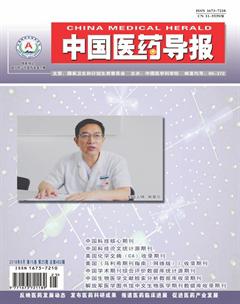介入治疗急性下肢动脉栓塞的临床研究
何景良 梁志会 李亮
[摘要] 目的 探討介入治疗急性下肢动脉栓塞的临床效果。 方法 选择2016年6月~2017年6月解放军白求恩国际和平医院诊治的急性下肢动脉栓塞60例,按照治疗方式的不同分为两组,其中对照组30例行大腔导管抽吸血栓治疗,实验组30例行大腔导管抽吸血栓+置管溶栓治疗。比较两组治疗效果和两组患者凝血酶原时间(PT)、活化部分凝血活酶时间(APTT)、纤维蛋白原(FIB)及D-二聚体(D-D)水平,观察两组患者的复发率及截肢率。 结果 治疗后,实验组总有效率明显高于对照组,差异有统计学意义(P < 0.05)。治疗后,两组APTT及PT水平均高于治疗前,且实验组显著高于对照组,差异有统计学意义(P < 0.05);两组FIB、D-D水平均明显低于治疗前,且实验组明显低于对照组,差异有统计学意义(P < 0.05)。治疗后,实验组栓塞复发发生率低于对照组,差异有统计学意义(P < 0.05),两组截肢率比较差异无统计学意义(P > 0.05)。 结论 临床中对急性下肢动脉栓塞患者应用大腔导管抽吸血栓+置管溶栓治疗效果显著,且并发症少,临床效果优于单纯应用大腔导管抽吸血栓治疗,可进行推广。
[关键词] 急性下肢动脉栓塞;介入治疗;大腔导管抽吸血栓;置管溶栓
[中图分类号] R654.4 [文献标识码] A [文章编号] 1673-7210(2018)09(a)-0071-04
[Abstract] Objective To investigate the clinical efficacy of interventional therapy for acute lower extremity arterial embolism. Methods From June 2016 to June 2017, in PLA Bethune International Peace Hospital, 60 patients with acute arterial embolism of lower extremity were selected, according to the treatment methods, they were divided into two groups, 30 cases in the control group were treated with large cavity catheter sucking thrombus, and 30 cases in the experiment group were treated with large cavity catheter sucking thrombolytic thrombolysis plus catheter thrombolytic therapy. The treatment effect, prothrombin time (PT), activated partial thromboplastin time (APTT), fibrinogen (FIB) and D-Dimer (D-D) level of the two groups were compared, and the recurrence rate and amputation rate of the two groups were observed. Results After treatment, the total effective rate of experiment group was significantly higher than that of control group, the difference was statistically significant (P < 0.05). After treatment, the levels of APTT and PT in the two groups were higher than those before treatment, and those in the experiment group were significantly higher than those of control group, the differences were statistically significant (P < 0.05), and the levels of FIB and D-D in the two groups were significantly lower than those before treatment, and those in the experiment group were significantly lower than those of control group, the differences were statistically significant (P < 0.05). After treatment, the incidence of embolic recurrence in the experiment group was lower than that of control group, the difference was statistically significant (P < 0.05). There was no significant difference in amputation rate between the experiment group and control group (P > 0.05). Conclusion The clinical effect of large cavity catheter suction thrombolysis plus catheter thrombolysis for patients with acute lower extremity arterial embolization is remarkable, and the complications are few, the clinical effect is better than that of the simple use of large cavity catheter suction thrombolytic therapy, and it can be popularized.
[Key words] Acute lower extremity arterial embolism; Interventional therapy; Large lumen catheter thrombus embolism; Catheter thrombolysis
急性下肢动脉栓塞是导致患者截肢的一个重要病因,该病的发病机制为:患者心脏或动脉血管中的栓子发生脱落进而导致血栓形成,或斑块阻塞血管,引起动脉栓塞,导致患肢循环障碍,引发缺血性疾病[1]。该病可导致患者患肢功能异常,造成不可逆的损伤,严重者可造成截肢或死亡[2]。对于急性下肢动脉栓塞,及时、快速、有效的治疗是改善患者预后的关键。大腔导管抽吸血栓是常用的治疗方法,但单独使用容易复发,且复通效果有限。本研究选择急性下肢动脉栓塞患者采取大腔导管抽吸血栓+置管溶栓的治疗方法,效果满意,现报道如下:
1 资料与方法
1.1 一般资料
选择2016年6月~2017年6月解放军白求恩国际和平医院收治的急性下肢动脉栓塞60例,排除合并高血压者、合并恶性肿瘤者、存在出血倾向者、近期行手术者及其他溶栓禁忌证者、介入手术禁忌证者。按照治疗方式的不同分为对照组和实验组,各30例。实验组中男20例,女10例;年龄44~79岁,平均(63.09±5.33)岁;栓塞发病时间4 h~7 d;均为单侧发病,其中右侧18例,左侧12例。对照组中男19例,女11例;年龄46~81岁,平均(64.17±5.73)岁;栓塞发病时间8 h~6 d;均为单侧发病,其中右侧20例,左侧10例。两组性别、年龄、发病时间、发病部位等一般资料比较,差异无统计学意义(P > 0.05),具有可比性。
1.2 治疗方法
1.2.1 实验组
1.2.1.1 大腔导管抽吸血栓术 麻醉后,行股动脉穿刺构建通路,或可选择患肢对侧逆行穿刺方法,选择8F或6F型号长鞘置入靠近栓子近端,再送入相应的导管。采取负压抽吸方法取出栓子,撤出导管。部分患者血栓抽吸效果不佳,应重复抽吸,提高抽吸效果。
1.2.1.2 置管溶栓术 置入溶栓导管,将微泵与导管末端进行连接,应用800 000~1 000 000 U尿激酶经微泵泵入治疗,并进行全身肝素化。灌注治疗期间维持活化部分凝血活酶时间(APTT)在60~90 s。置管溶栓治疗24 h后观察溶栓情况。置管溶栓治疗最长5 d,5 d后停止溶栓。在结束所有介入治疗后,给予华法林抗凝治疗。
1.2.2 对照组
对照组仅实施大腔导管抽吸血栓术治疗,方法和实验组相同。
1.3 疗效评价标准
1.3.1 疗效评估
在治疗后评估两组疗效,按照Cooley疗效标准进行评价[3],分为治愈、优、良、差。①治愈:经治疗后栓塞患肢循环及动脉搏动均恢复正常;②优:栓塞患肢经治疗后功能恢复,但仍残存缺血现象;③良:经治疗后栓塞患肢循环恢复,但动脉搏动尚未恢复正常;④差:治疗后急性下肢动脉栓塞无改善或加重。总有效率=(治愈+优+良)/总例数×100%。
1.3.2 并发症
观察并比较两组介入治疗期间的并发症发生情况、治疗后半年的复发情况。
1.3.3 APTT、凝血酶原時间(PT)、纤维蛋白原(FIB)及D-二聚体(D-D)
采用Sysmex CA-1500全自动血液凝固分析仪检测APTT及PT水平,采用磁珠法检测FIB,采用免疫比浊法检测D-D水平。
1.4 统计学方法
采用统计软件SPSS 19.0对数据进行分析,正态分布的计量资料以均数±标准差(x±s)表示,两组间比较采用t检验;计数资料以率表示,采用χ2检验。以P < 0.05为差异有统计学意义。
2 结果
2.1 两组治疗效果比较
治疗后,实验组总有效率明显高于对照组,差异有统计学意义(P < 0.05)。见表1。
2.2 两组治疗前后凝血指标及D-D变化情况比较
治疗后,两组APTT及PT水平高于治疗前,且实验组明显高于对照组,差异有统计学意义(P < 0.05);两组FIB、D-D水平低于治疗前,且实验组明显低于对照组,差异有统计学意义(P < 0.05)。见表2。
2.3 两组栓塞复发率及截肢率比较
治疗后,实验组栓塞复发率低于对照组,差异有统计学意义(P < 0.05)。两组截肢率比较,差异无统计学意义(P > 0.05)。见表3。
3 讨论
动脉栓塞是指心脏或动脉壁脱落的血栓或斑块等,随血流向远侧流动,造成动脉堵塞、血流障碍的机型病变[4-5]。动脉栓塞主要由血栓造成,此外,癌栓、空气、脂肪等异物都可能成为栓子,其中尤以心源性最为多见。患者年龄以50岁以上多见,常合并心血管疾病[6-7]。急性下肢动脉栓塞主要发生于中老年人群,是临床常见的外周血管疾病,该病发病快,进展迅速,且可造成不可逆的损伤,若治疗措施不当或不及时,会造成患者致残或死亡[8-9]。临床对该病的治疗方法较多,包括手术取栓、置入溶栓等。凡是动脉栓塞的患者,除非肢体已发生坏疽,或有良好的侧支建立可以维持肢体的存活,如果患者全身情况允许,应及时手术取栓[10-11]。
急性动脉栓塞起病急骤、严重威胁肢体的生存,甚至患者的生命。曾有报道在急性栓塞后数日或数周施行后期取栓术成功[12-13]。可见发病的时间并不是手术绝对指征,只要肢体没有发生大片坏死,有存活的可能性,都应积极争取手术,取栓可以挽救肢体或降低截肢平面[14-15]。而对于中晚期已发生部分坏疽的急性下肢动脉栓塞者,手术可以起到改善患者预后的积极作用。研究发现,对于中晚期急性动脉栓塞患者采取手术治疗或保守治疗的效果差异无统计学意义[16-17]。
在急性下肢动脉栓塞治疗中,大腔导管抽吸血栓治疗是一种操作简便、费用不高、且效果较好的方法,其能够快速恢复患肢循环,减少缺血性损伤,加快患者康复[18]。但大腔导管抽吸血栓中,一些栓子抽吸效果不佳,加上抽吸过程中会造成部分栓子脱落,容易再次造成栓塞,因此结合置管溶栓能够降低再次栓塞的可能[19]。置管溶栓通过灌注药物,使药物直接作用于栓子,再配合全身肝素化治疗,能够预防栓子再次聚集,尤其对于急性期血栓具有优效。临床多数研究主要单用大管径抽吸血栓治疗、置管溶栓治疗等[20]。本研究在多数研究基础上,对急性下肢动脉栓塞患者采用大腔导管抽吸血栓+置管溶栓的综合性治疗方法,结果显示,实验组总有效率为100.0%,高于对照组的83.3%,且实验组栓塞复发率低于对照组(P < 0.05)。提示对急性下肢静脉栓塞患者应用大腔导管抽吸血栓+置管溶栓治疗方法效果优于单用大腔导管抽吸血栓治疗。
综上所述,临床中对急性下肢动脉栓塞患者应用大腔导管抽吸血栓+置管溶栓治疗效果显著,且并发症少,临床效果优于单纯应用大腔导管抽吸血栓治疗,可进行推广。
[参考文献]
[1] 赵健,刘兆玉,马羽佳,等.大管径导管抽吸血栓治疗急性下肢动脉栓塞的療效分析[J].医学影像学杂志,2017, 27(8):1546-1549.
[2] 赵国瑞,任建庄,陈鹏飞,等.急性下肢动脉栓塞导管取栓与支架植入临床疗效对比分析[J].介入放射学杂志,2016,25(10):853-857.
[3] 王建国,孙沛达,刘海燕,等.动脉取栓术与介入溶栓治疗急性下肢动脉栓塞的复通情况观察[J].中西医结合心血管病杂志:电子版,2017,5(27):45.
[4] Yang Y,Zhang X,Zhou C,et al. Elevated immunoreactivity of RANTES and CCR1 correlate with the severity of stages and dysmenorrhea in women with deep infiltrating endometriosis [J]. Acta Histochem,2013,115(5):434-439.
[5] Govatati S,Kodati VL,Deenadayal M,et al. Mutations in the PTEN tumor gene and risk of endometriosis:a case–control study [J]. Hum Reprod,2013,29(2):324-336.
[6] Chang JH,Au HK,Lee WC,et al. Expression of the pluripotent transcription factor OCT4 promotes cell migration in endometriosis [J]. Fertil Steril,2013,99(5):1332-1339.
[7] Jowicz AP,Brown JK,McDonald SE,et al. Characterization of the temporal and spatial expression of a disintegrin and metalloprotease 17 in the human endometrium and fallopian tube [J]. Reprod Sci,2013,20(11):1321-1326.
[8] Nepomnyashchikh LM,Lushnikova EL,Molodykh OP,et al. Immunocytochemical analysis of proliferative activity of endometrial and myometrial cell populations in focal and stromal adenomyosis [J]. Bull Exp Biol Med,2013,155(4):512-517.
[9] Saare M,Soritsa D,Vaidla K,et al. No evidence of somatic DNA copy number alterations in ectopic and ectopic endometrial tissue in endometriosis [J]. Hum Reprod,2012, 27(6):1857-1864.
[10] Benagiano G,Brosens I. The endometrium in adenomyosis [J]. Womens Health (Lond),2012,8(3):301-312.
[11] Shaw JL,Horne AW. The paracrinology of tubal ectopic pregnancy [J]. Mol Cell Endocrinol,2012,358(2):216-222.
[12] van Esch EM,Smeets MJ,Rhemrev JP. Treatment with methotrexate of a cornual pregnancy following endometrial resection [J]. Eur J Contracept Reprod Health Care,2012,17(2):170-174.
[13] Canlorbe G,Goubin-Versini I,Azria E,et al. Ectopic decidua:variability of presentation in pregnancy and differential diagnoses [J]. Gynecol Obstet Fertil,2012,40(4):235-240.
[14] Kodithuwakku SP,Pang RT,Ng EH,et al. Wnt activation downregulates olfactomedin-1 in Fallopian tubal epithelial cells:a microenvironment predisposed to tubal ectopic pregnancy [J]. Lab Invest,2012,92(2):256-264.
[15] Lee B,Du H,Taylor HS. Experimental murine endometriosis induces DNA methylation and altered gene expression in eutopic endometrium [J]. Biol Reprod,2009,80(1):79-85.
[16] Fassbender A,Verbeeck N,B?觟rnigen D,et al. Combined mRNA microarray and proteomic analysis of eutopic endometrium of women with and without endometriosis [J]. Hum Reprod,2012,27(7):2020-2029.
[17] Hu WP,Tay SK,Zhao Y. Endometriosis-specific genes identified by real-time reverse transcription-polymerase chain reaction expression profiling of endometriosis versus autologous uterine endometrium [J]. J Clin Endocrinol Metab,2006,91(1):228-238.
[18] Hur SE,Lee JY,Moon HS,et al. Angiopoietin-1,angiopoietin-2 and Tie-2 expression in eutopic endometrium in advanced endometriosis [J]. Mol Hum Reprod,2006,12(7):421-426.
[19] Matsuzaki S,Darcha C. Adenosine triphosphate-binding cassette transporter G2 expression in endometriosis and in endometrium from patients with and without endometriosis [J]. Fertil Steril,2012,98(6):1512-1520. e3.
[20] Brosens I,Brosens J,Benagiano G. The eutopic endometrium in endometriosis:are the changes of clinical significance [J]. Reprod Biomed Online,2012,24(5):496-502.
(收稿日期:2018-03-05 本文編辑:苏 畅)

